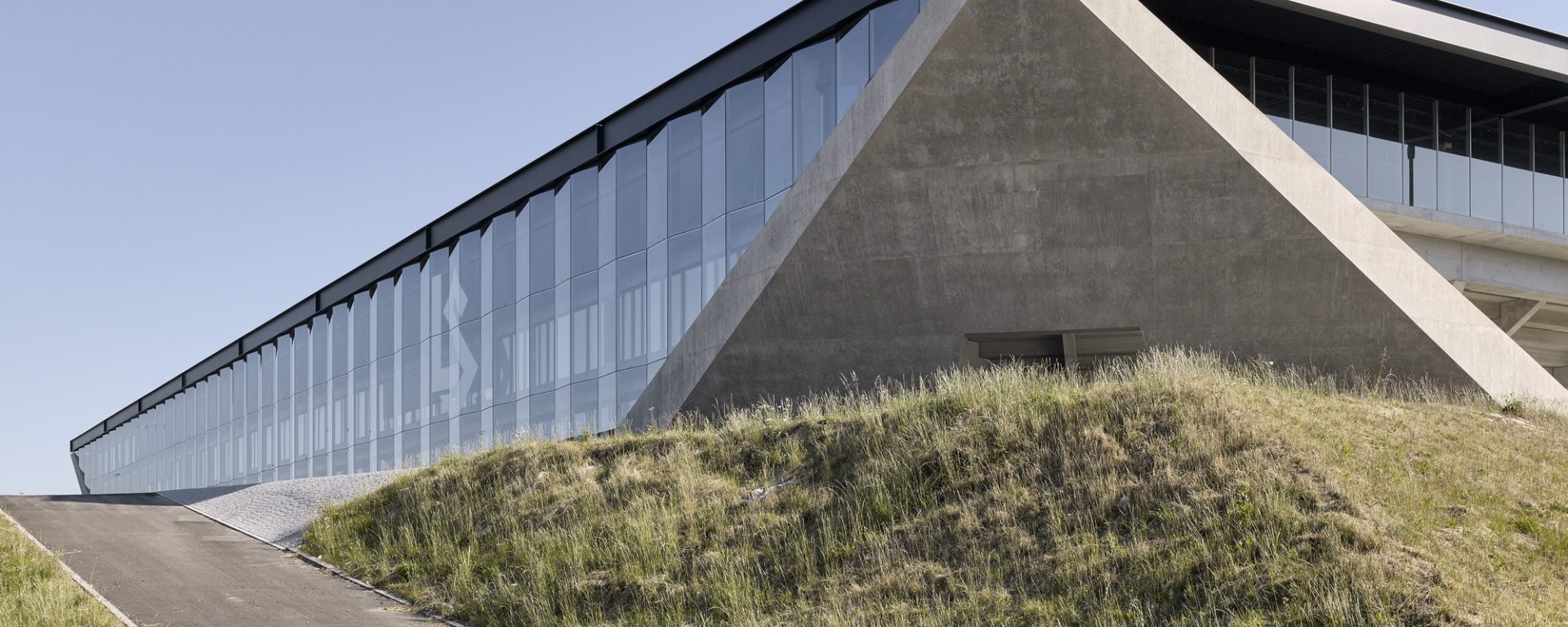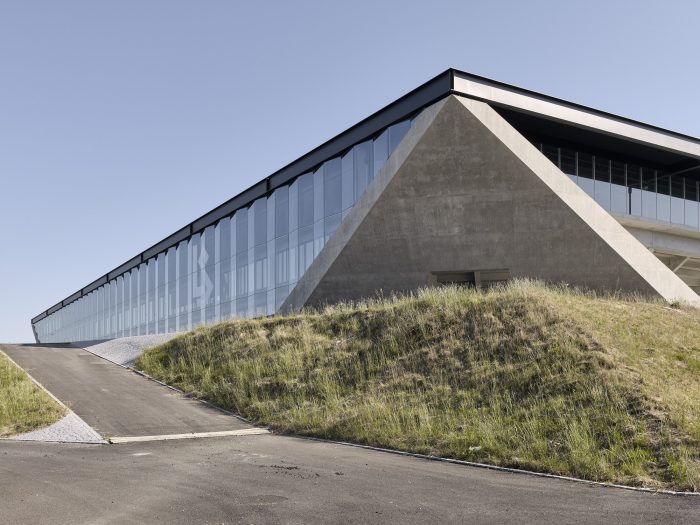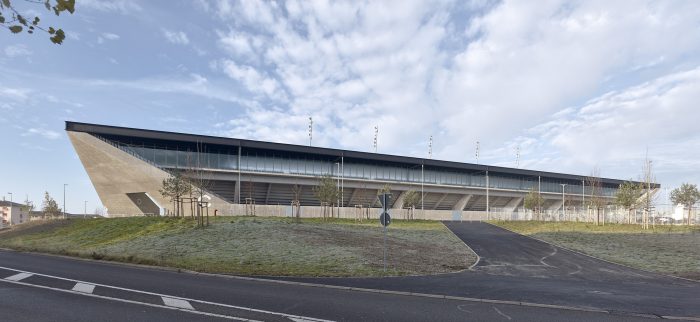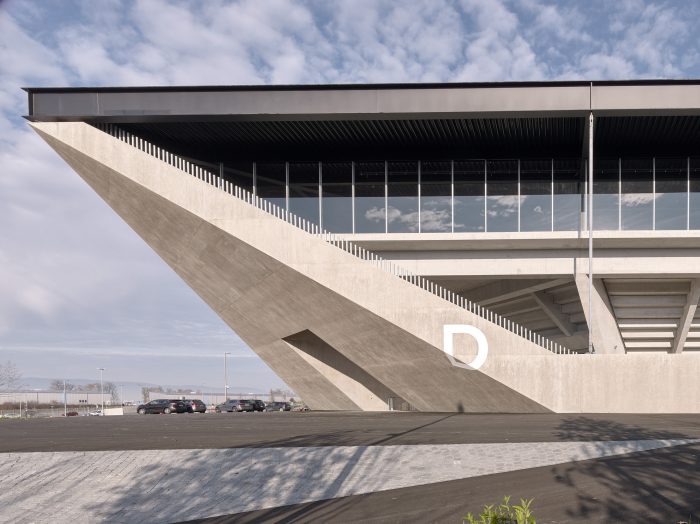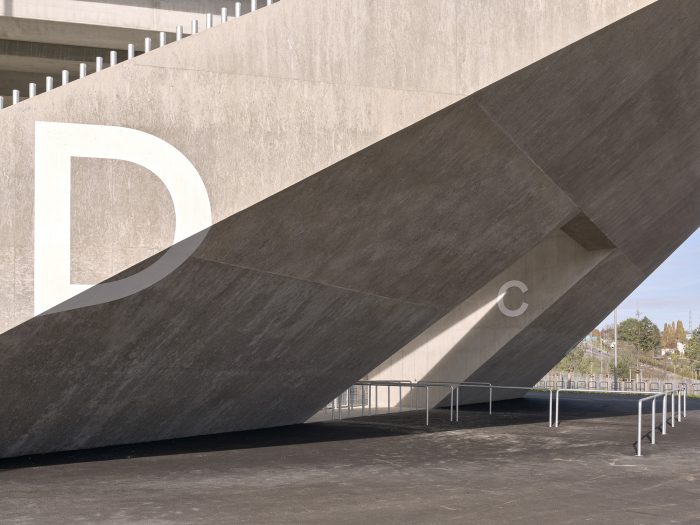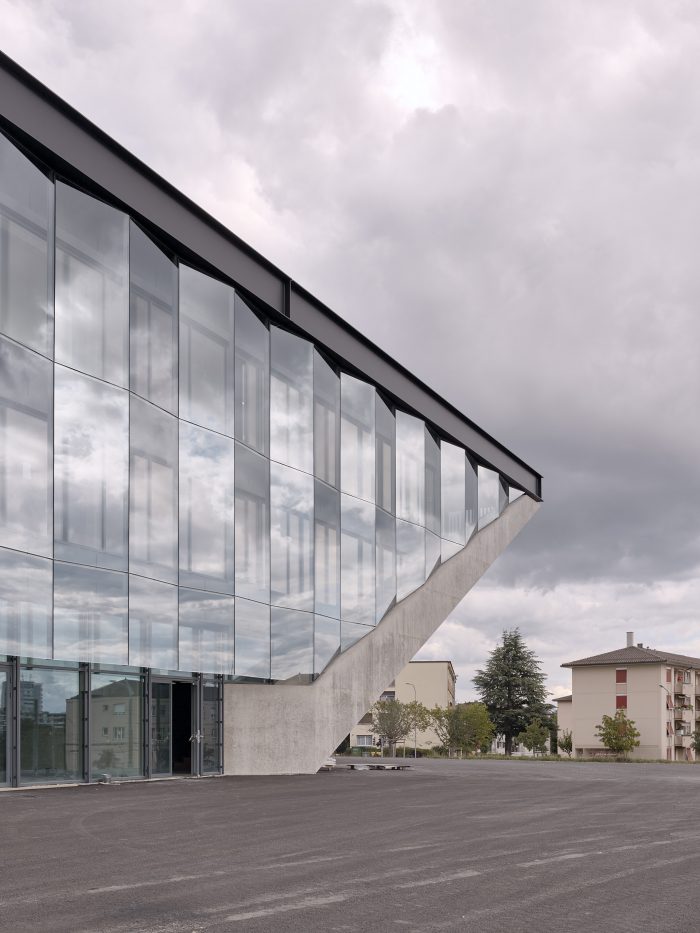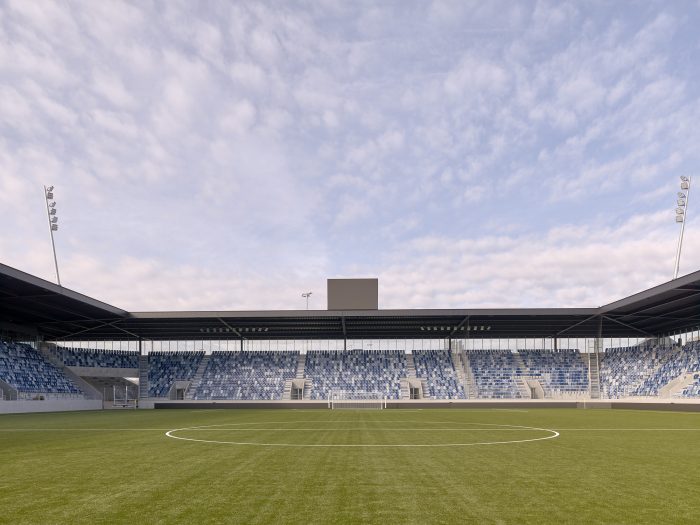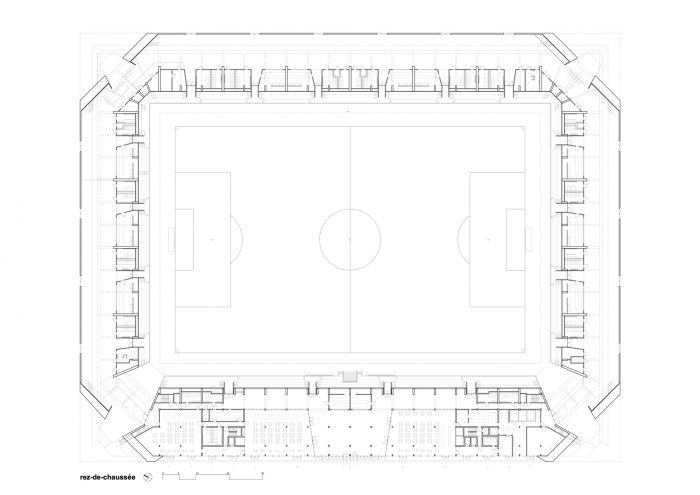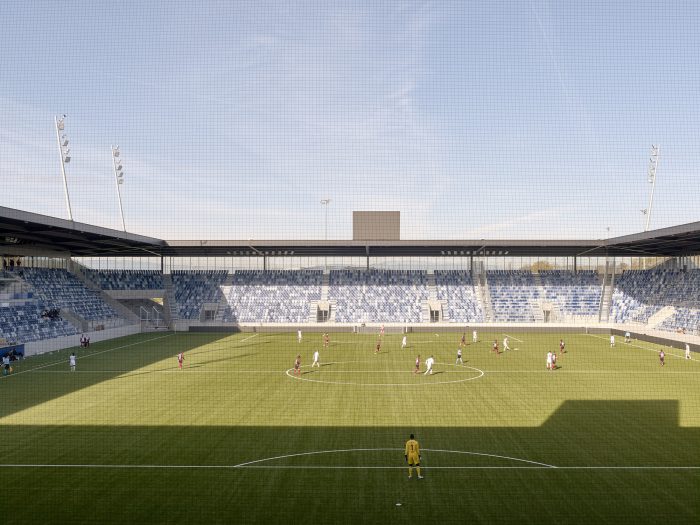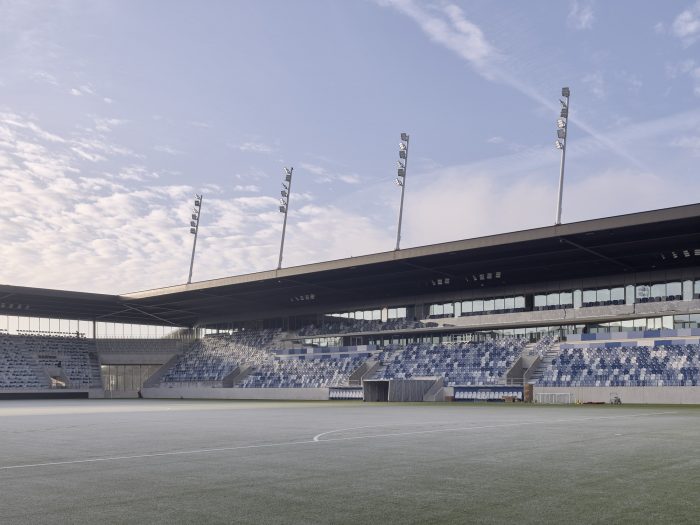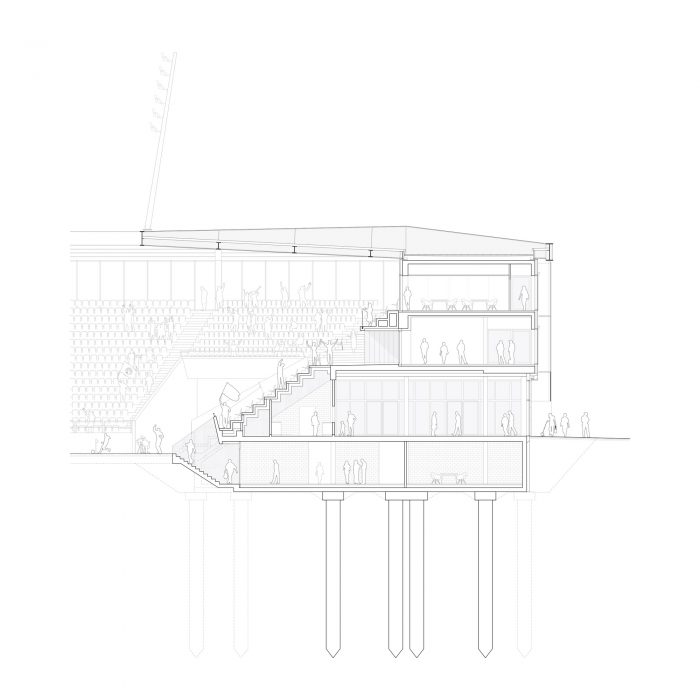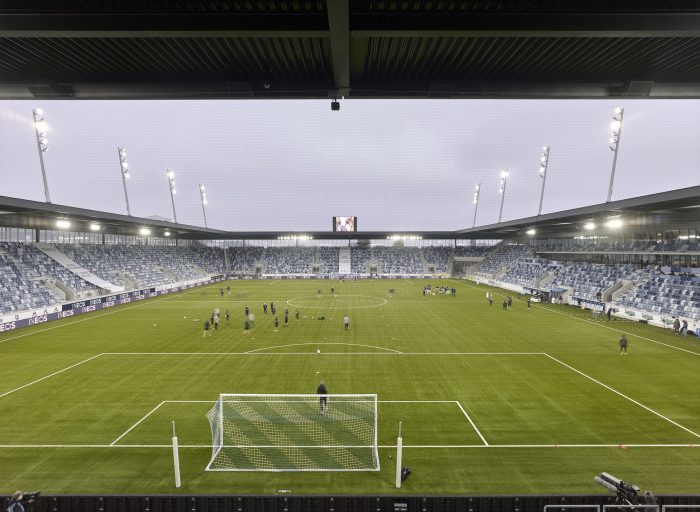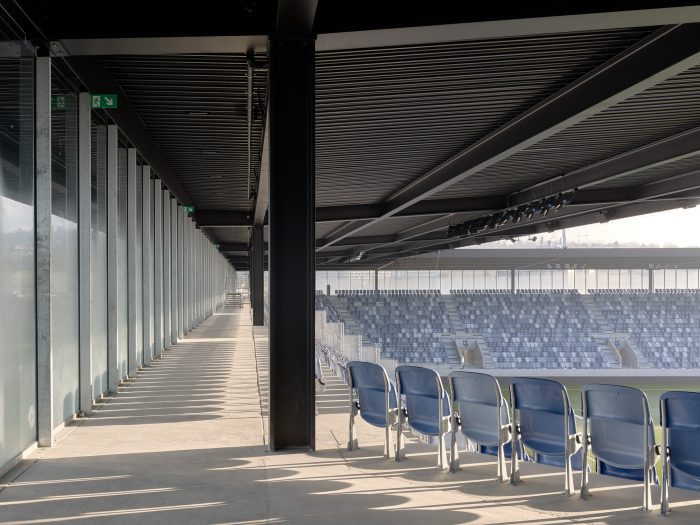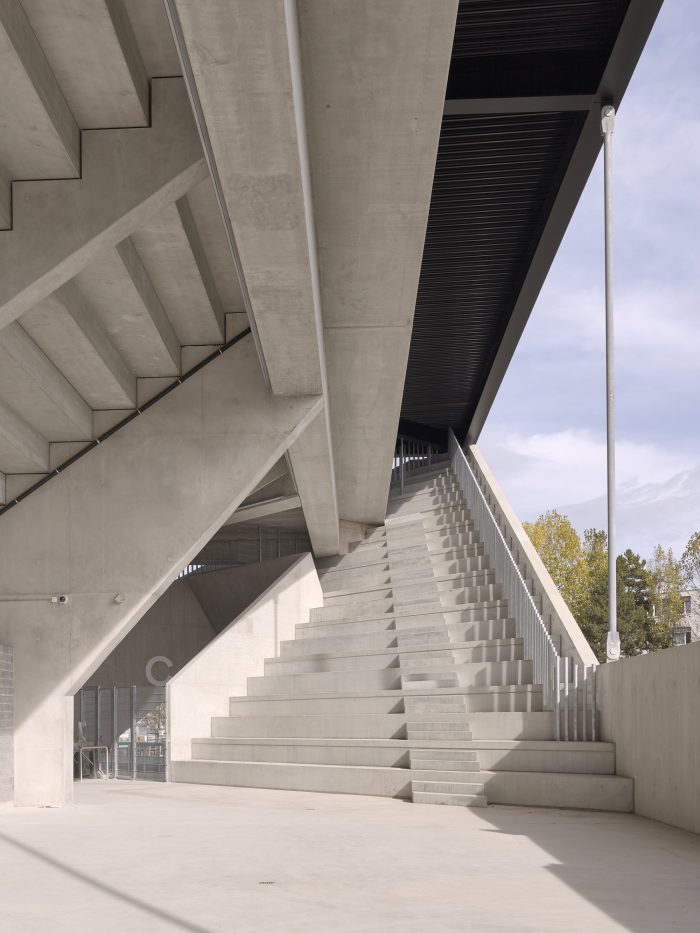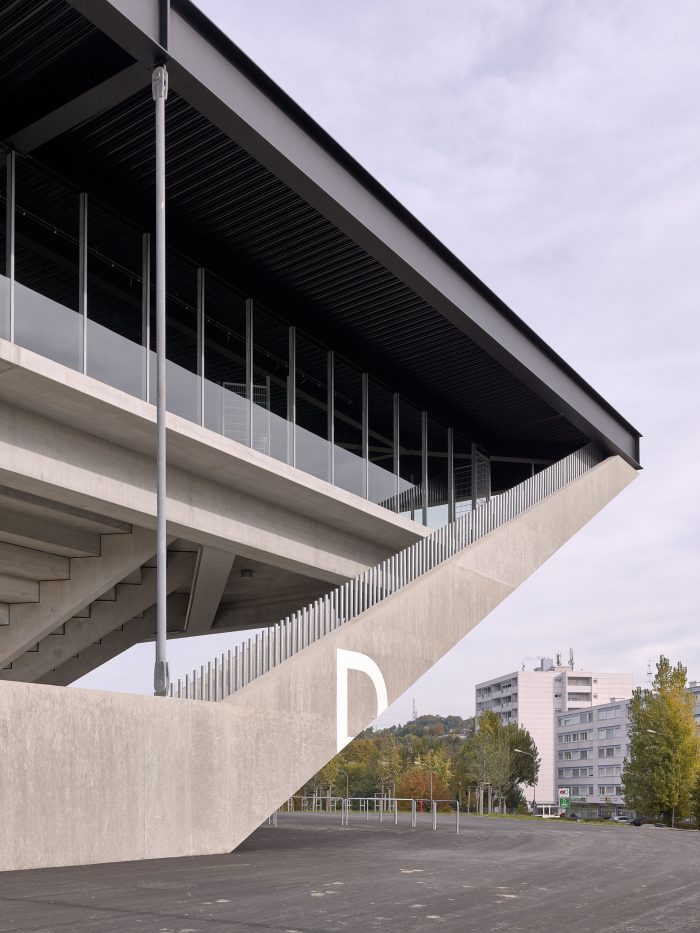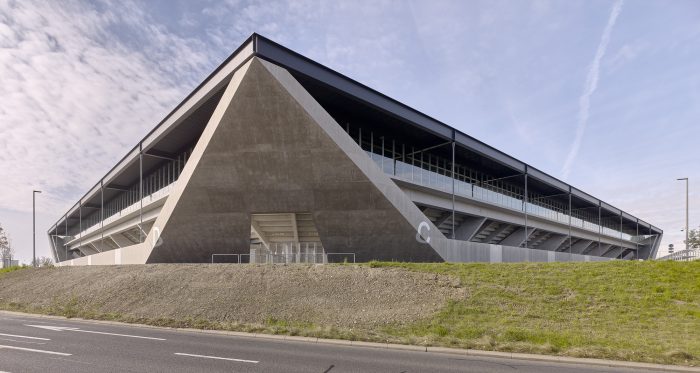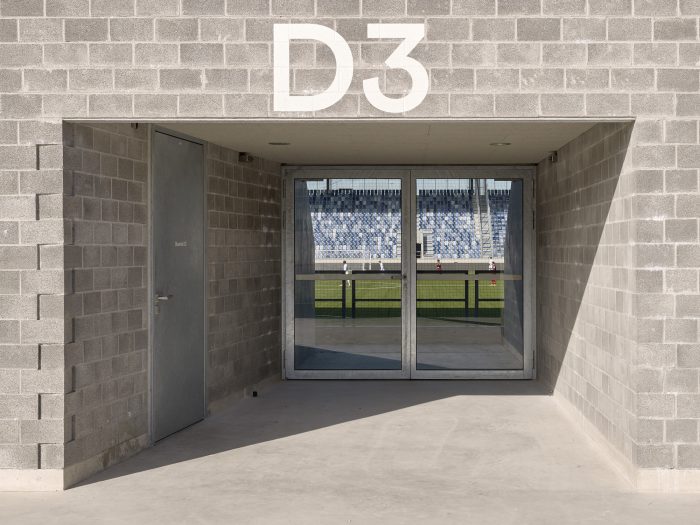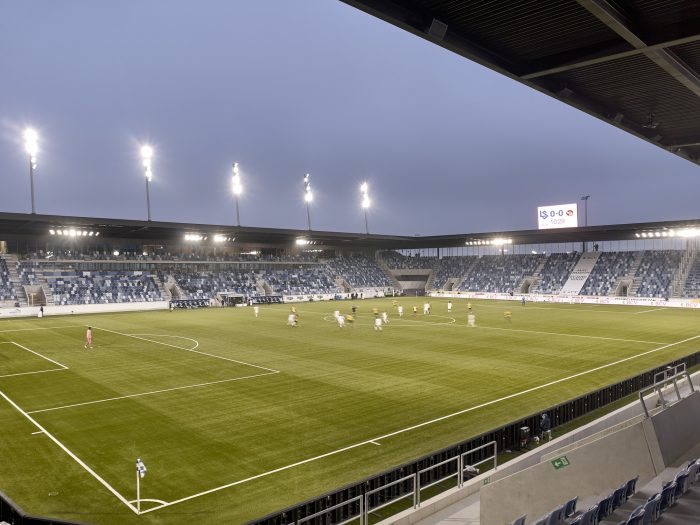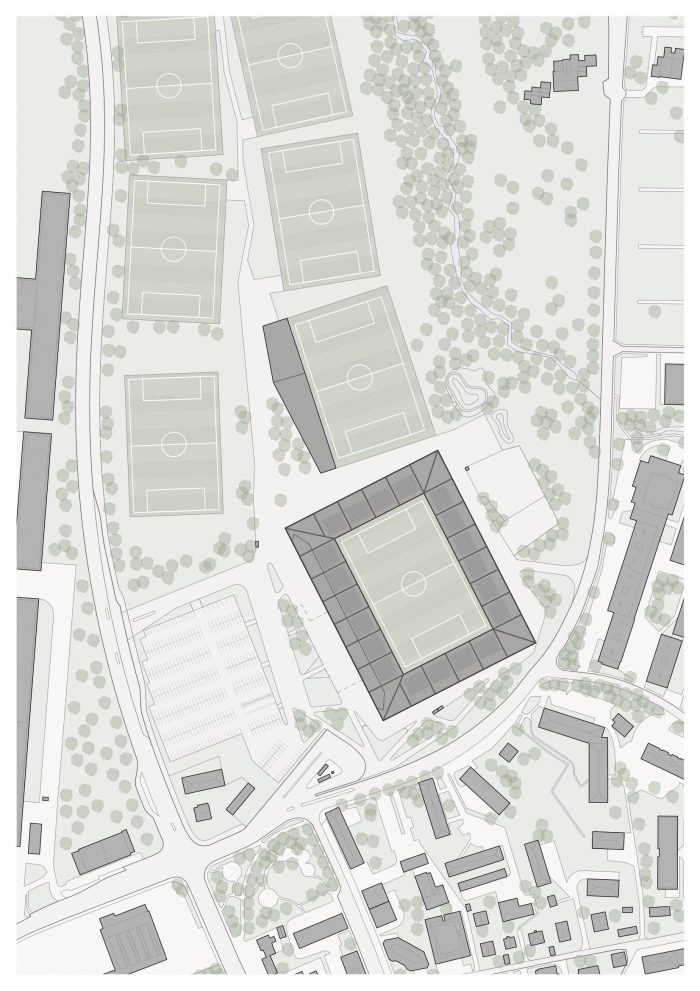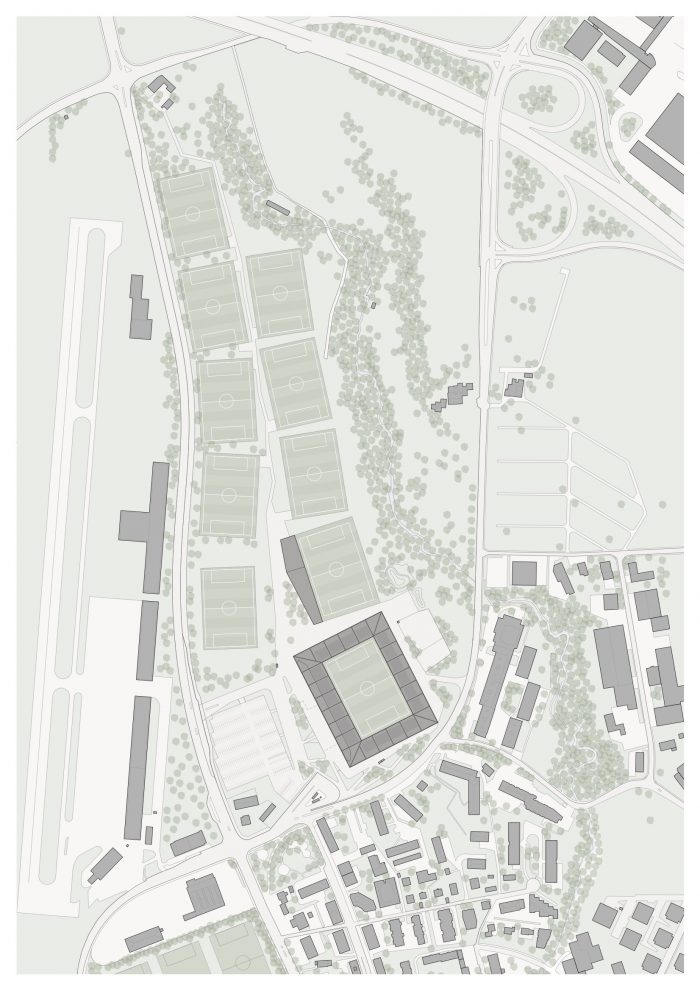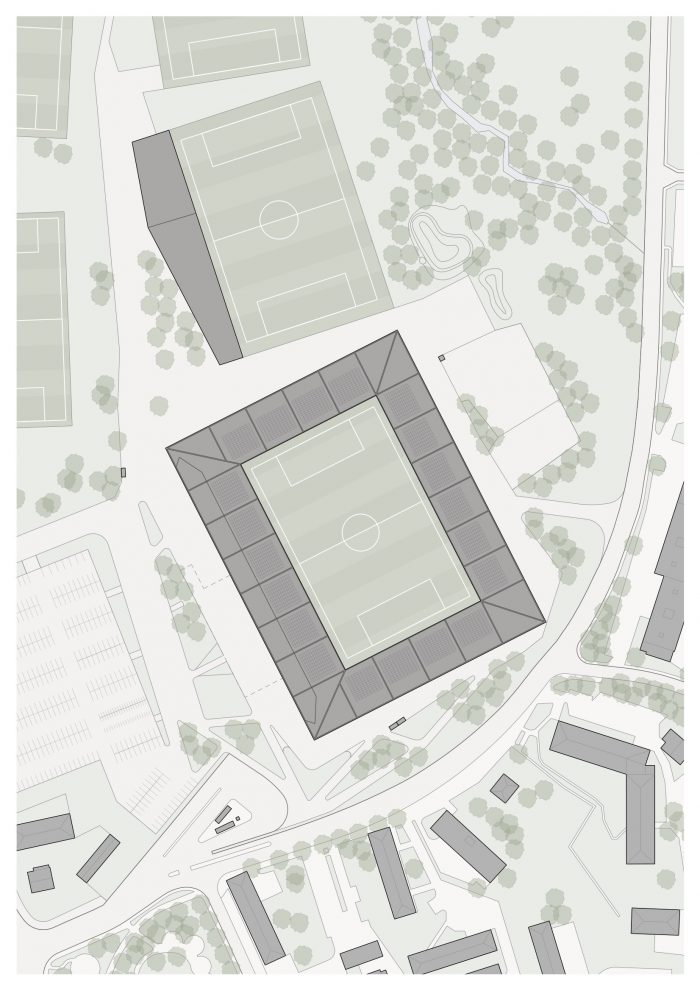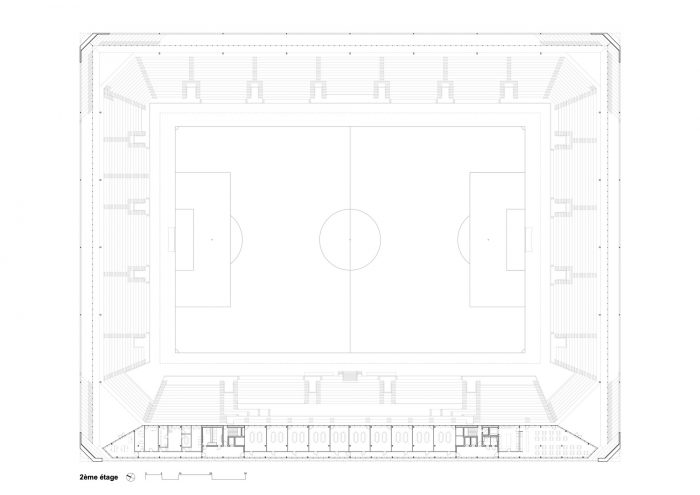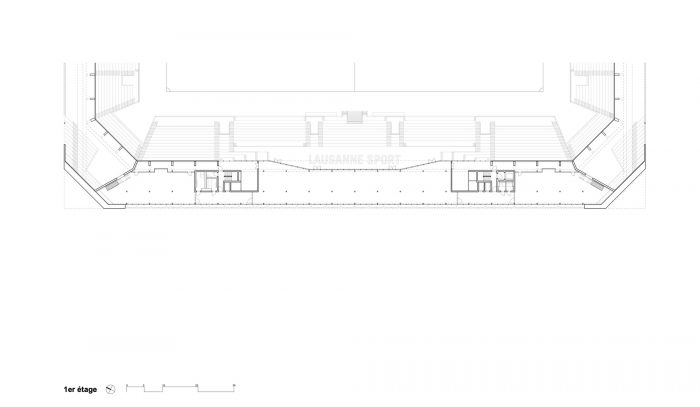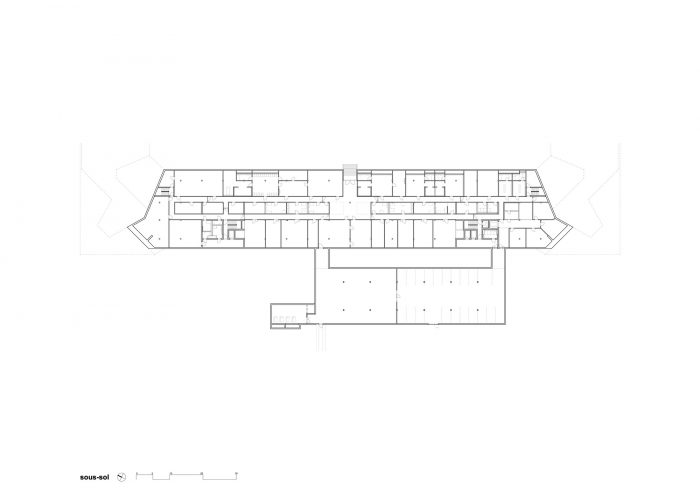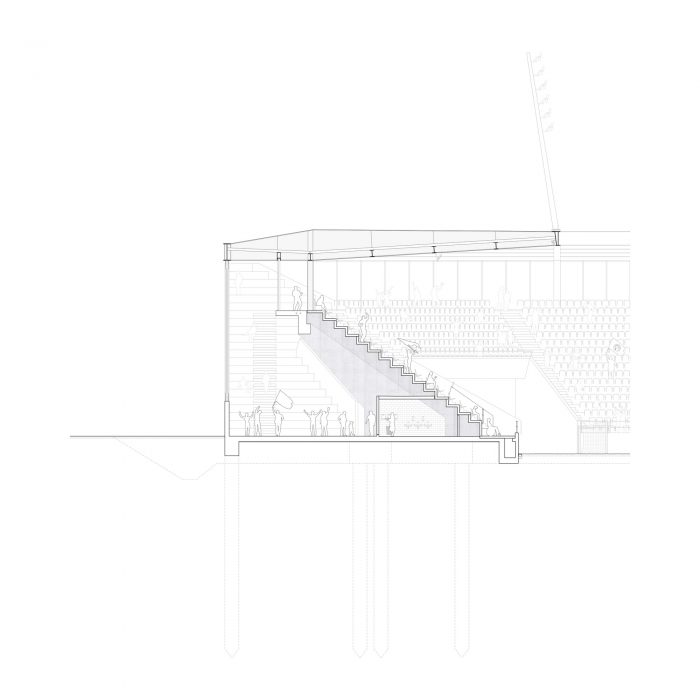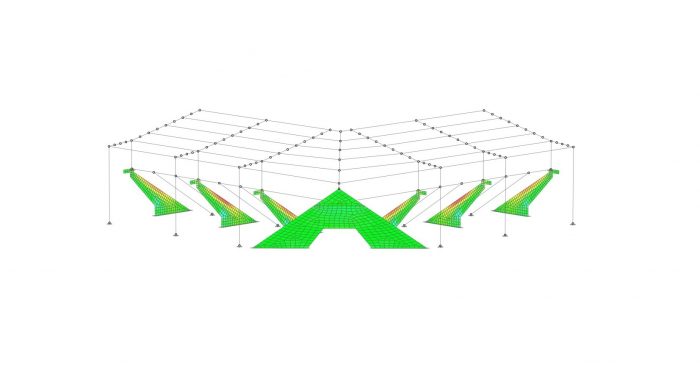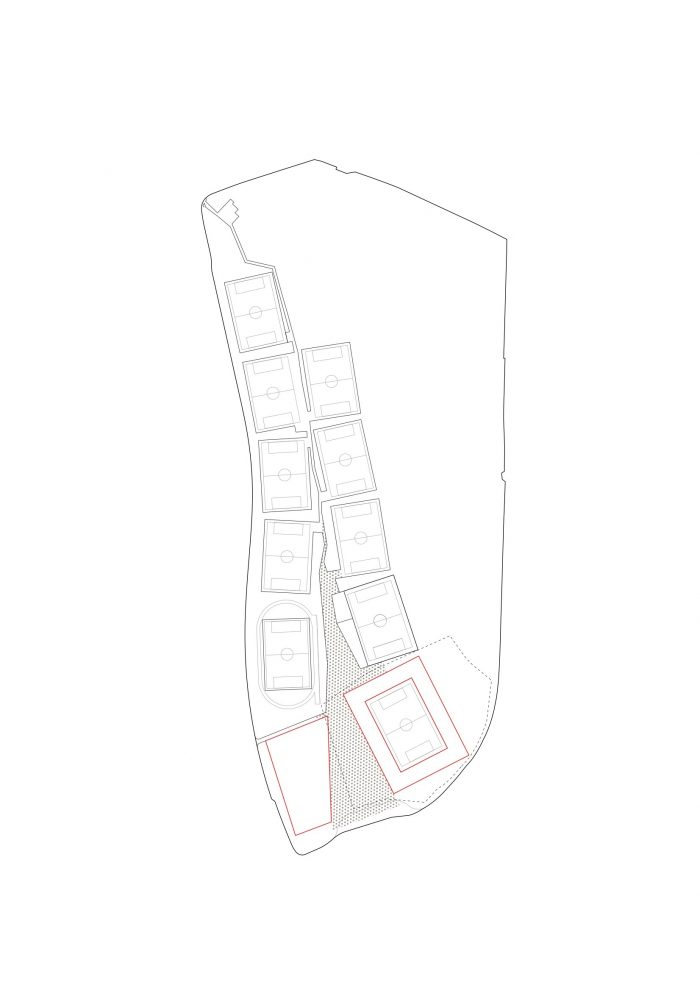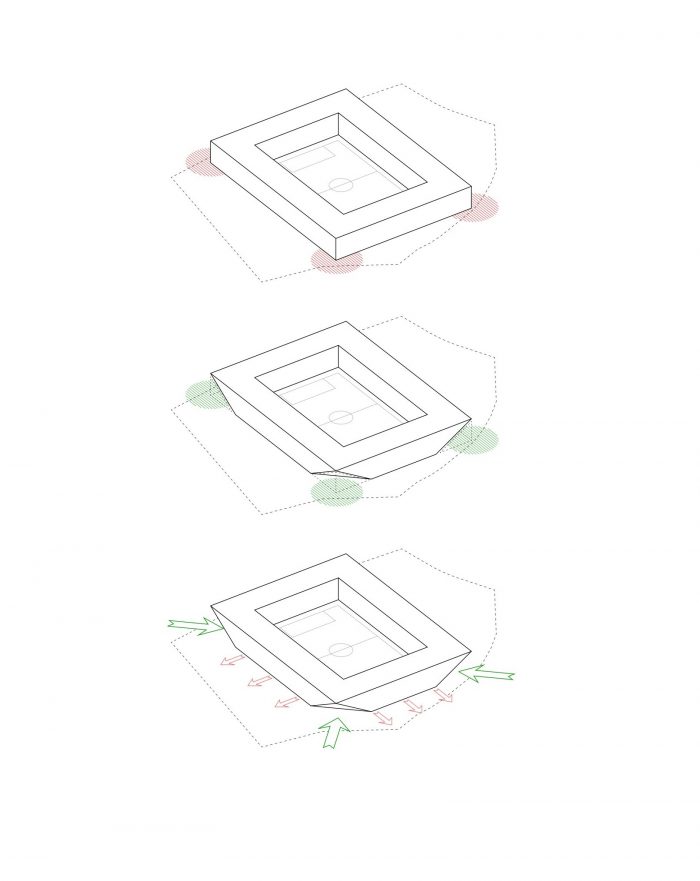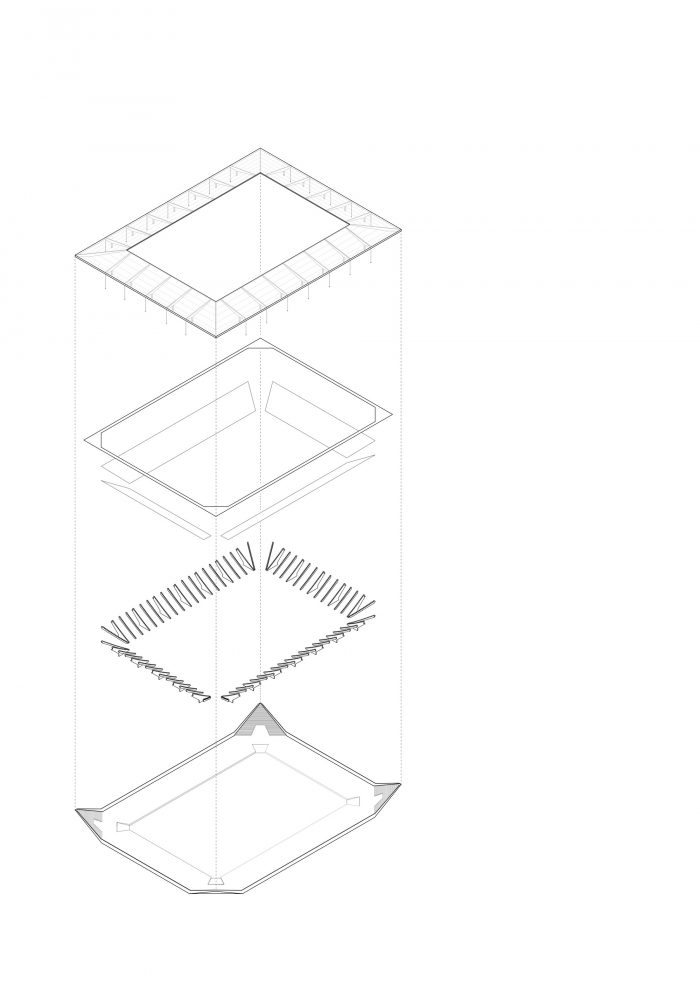新的足球场位于洛桑市北部,在城市密集的城市结构与开阔的乡村之间。新的 “Centre Sportif de la Tuilière “的体育基础设施包括9个足球场,分两排排列,此外还有一个带有训练中心的田径设施。该体育场采用了略微偏移的矩形球场的设计理念,并将其更进一步。体育场广场的位置与训练场略微倾斜,形成了体育园区的城市入口。
The new football stadium is located in the Northern part of the city of Lausanne, at the point where the city’s dense urban fabric gives way to the more open countryside. The sports infrastructure at the new “Centre Sportif de la Tuilière” comprises nine football pitches, arranged in two rows, in addition to an athletics facility with a training centre. The stadium picks up on the idea of the slightly offset rectangular pitches, taking it even further. Positioned at a slight angle to the training pitches, the stadium square is orchestrated to form the city-side entry point to the sports campus.
新的足球场只用于足球比赛和大型活动,没有任何外围用途。其有限的部署和它在城市郊区的位置允许设计完全集中在体育场作为一个体育设施。以其独特的、令人难忘的结构,它是身份和记忆的载体。陡峭的看台将观众带到了球场上,低矮的屋顶放大了球迷们呐喊的背景噪音,使其充满了情感。因此,建筑通过其结构性措施,在很大程度上提升了球队的主场优势。”洛桑体育俱乐部 “的建筑、历史和身份都要融合成一个整体。
The new football stadium is intended exclusively for football matches and major events, with no peripheral uses. Its limited deployment and its location on the outskirts of the city permit a design-focused fully on the stadium as a sports facility. With its distinctive, unforgettable structure, it serves as a carrier of identity and memories. Its architecture emotionalises with the steep stands bringing spectators right up to the action on the pitch and the low roof amplifying the background noise of the chanting fans. The architecture thus contributes in no small way of boosting the team’s home advantage through its structural measures. The building, history, and identity of “FC Lausanne-Sport” are all to merge into a single whole.
将体育场的四个角向后折叠,可以根据场地的狭小空间进行设计。巧妙的转角方案允许游客在建筑的底层自由流动,将体育场广场与周边区域连接起来。同时,它还创造了一个有盖的公共空间,作为中间人,协调外部与内部,以及城市与足球场的关系。这些角落同时也是入口区域,为人们提供了初步的球场视野,让人们从外面就能感受到球场的气氛。
Folding back the four corners of the stadium enables the design to be tailored to the confined space on the site. The ingenious corner solution permits a generous free flow of visitors around the building at ground-floor level, linking the stadium square to its surrounding areas. At the same time, it creates a covered public space to serve as a go-between, reconciling the outside with the inside and the city with the football stadium. The corners simultaneously serve as entrance areas, providing initial glimpses of the pitch and allowing the atmosphere in the stadium to be already savoured from the outside.
折叠的四角也给体育场带来了令人印象深刻的,明确无误的,甚至是标志性的凸形容器的外观,表明了它的用途和内在的东西。此外,这种独特的形状对建筑的静力学也有一定的作用,因为角部对体育场顶部边缘的环形梁施加了拉应力,使四面外墙具有刚性。在基座区域,四个角由单层混凝土带连接。这为体育场的外壳美学画上了一个句号。在功能和视觉上,这面 “幕墙 “将底层的辅助功能,包括餐饮、流通和休息区与周围区域隔开,将它们融入到建筑中。
The folded-back corners also lend the stadium the impressive, unmistakable, and even iconic look of a convex vessel, indicative of its use and what lies within. This distinctive shape additionally has a role to play in the building’s statics by the corners exerting tensile stress on the ring girders running around the top edge of the stadium, imparting rigidity to the four outside walls. In the plinth area, the four corners are linked by a single-storey concrete band. This puts the finishing touch to the aesthetics of the stadium’s outer shell. In functional and visual terms, this “curtain wall” separates the ancillary functions on the ground floor, which include catering, circulation, and lounge zones, from the surrounding area, integrating them in the building.
在这个外壳内刻画的是第二个内壳,由看台的几何形状形成。从看台上切出的 “口孔 “提供了通往最里面区域的通道。两个外壳之间的空间就像一个共鸣箱,放大了球场上发生的事情:一个期待、交流和相遇的地方。在这些空间的窄边上,人们的目光被吸引到角落的阶梯式内侧。它们提供了从入口层到环绕顶部的走道的进一步通道,从而产生了额外的功能价值。走道由上述的张拉梁形成,连接建筑的四个角。此时设计的变化,从下部的厚重混凝土到上部的细长钢结构,在建筑上也突出了走道的特点。特别是在没有观众隔离的大型活动中,它邀请游客通过不同的路线进入自己的座位,获得新的视角。很明显,这里已经达到了最高点。视野向四周延伸,洛桑市、日内瓦湖和阿尔卑斯山的全景尽收眼底。
Inscribed within this outer shell is a second, inner shell, shaped by the geometry of the stands. “Mouth holes” cut out of the stands provide access to the innermost zone. The space between the two shells is like a resonance box, amplifying the happenings on the pitch: a place of anticipation, exchange, and encounters. On the narrow sides of these spaces, the gaze is drawn to the stepped inner sides of the corners. These provide further access from the entry-level to the walkway around the top, thus generating additional functional value. The walkway is formed by the tensioned girders mentioned above, connecting the four corners of the building. The change in design at this point, from heavy concrete in the lower section to a slender steel structure above, highlights the walkway in architectural terms as well. Especially during major events without spectator segregation, it invites visitors to access their seats via different routes gaining new perspectives. It is clear here that the topmost point has been reached. The view extends in all directions, offering a breathtaking panorama over the city of Lausanne, Lake Geneva, and the Alps.
虽然体育场拥有壮观的外观和中间区域的壮丽景色,但内部的线条却散发着宁静的气息。在这里,球场和球场上的主角们占据了戏剧性的地位。没有添加任何可能引起分心的东西,甚至连座位排都是在角落里水平排列的。从内部外壳中出现的呕吐物几乎完全平静地融入到画面中。即使是商务区和贵宾区也与座位的几何形状相匹配。一切都服从于体育场的目的:比赛。
While the stadium boasts spectacular exterior and splendid views from its intermediate zone, the lines on the inside exude tranquillity. It is the pitch and the protagonists acting on it that take over the dramaturgy here. Nothing which could cause distraction was added, even the seating rows run horizontally around the corners. The vomitories emerging from the inner shell blend into the picture almost completely calm. Even the business and VIP zones are matched to the geometry of the seating. Everything is in servitude to the stadium’s purpose: the game.
在外部,梁的几何形状和看台的底部在体育场的三面占主导地位。而西侧则是具有特定用途的主看台。各种衣帽间、媒体和贵宾区通过玻璃表皮一览无余,共三层。垂直配置的玻璃条之间有柔和的褶皱,增强了这个立面只是一个轻盈的玻璃幕墙的印象。其零碎的反射打破了建筑的巨大规模。整个建筑群不仅是一个新的城市广场的背景,也为洛桑市创造了一个突出的新地标。
On the outside, the geometry of the beams and the underside of the stands dominate the stadium on three sides. The west side, by contrast, houses the main stand with its specific uses. The various cloakrooms, press, and VIP zones are visible over three floors through a filigree glass skin. Gentle creases between the vertically configured strips of glass enhance the impression that this façade is just a light glass curtain. Its fragmented reflections break up the vast scale of the building. This entire complex not only serves as a backdrop to a new city square but also creates a prominent new address for the city of Lausanne.
足球场周围的区域与洛桑市上空的 “Plaines-du-loup “景观融为一体。毗邻的机场、”petit Flon “小河,以及随之而来的灌木和灌木提供了背景环境。几组树木的绿色体量与体育场建筑和运动场形成了对立。天然草甸和野生灌木扩展了自然公园的范围,大面积的绿地界定了新体育场的开放空间。
The areas around the football stadium blend into the “Plaines-du-loup” landscape above the city of Lausanne. The adjacent airport, the small “petit Flon” river, and the accompanying bushes and shrubs deliver the contextual setting. The green volumes of several groupings of trees form a counterpoint to the stadium building and the sports fields. Natural meadows and wild shrubs extend the natural park, with the generously dimensioned green areas defining the open space towards the new stadium.
建筑师: :mlzd, Sollberger Bögli建筑事务所
面积:19200平方米
年份:2020年
照片:Ariel Huber
Project Team:Mlzd:Pat Tanner, Daniele Di Giacinto, Alain Brülisauer, Andreas Frank, Claude Marbach, David Locher, Adrian Widmer, Camille Schneider, Eliane Lehmann, Brigitte Ballif, Delphine Kohler, Robert Ilgen, Johannes Weisser, Benjamin Minder, Julia Wurst, Pascal Deschenaux, Magdalena Haslinger, Tobias Cebulla, Claudia Schmidt, Jonatan Anders, Natascha Kellner
Project TeamSollberger Bögli Architekten :Ivo Sollberger, Lukas Bögli, Bernard Luisier, Silas Maurer, Kevin Fuchs, Josué von Bergen, Patrick Wüthrich。
结构工程和外墙工程 :Dr. Lüchinger+Meyer Bauingenieure AG Zurich, Inc.
艺术作品:Florian Graf, floriangraf.ch
城市:洛桑
国家:瑞士
Architects: :mlzd, Sollberger Bögli Architekten
Area: 19200 m²
Year: 2020
Photographs: Ariel Huber
Project Team :Mlzd:Pat Tanner, Daniele Di Giacinto, Alain Brülisauer, Andreas Frank, Claude Marbach, David Locher, Adrian Widmer, Camille Schneider, Eliane Lehmann, Brigitte Ballif, Delphine Kohler, Robert Ilgen, Johannes Weisser, Benjamin Minder, Julia Wurst, Pascal Deschenaux, Magdalena Haslinger, Tobias Cebulla, Claudia Schmidt, Jonatan Anders, Natascha Kellner
Project Team Sollberger Bögli Architekten :Ivo Sollberger, Lukas Bögli, Bernard Luisier, Silas Maurer, Kevin Fuchs, Josué von Bergen, Patrick Wüthrich
Structural Engineering & Facade Engineering :Dr. Lüchinger+Meyer Bauingenieure AG Zürich
Artwork:Florian Graf, floriangraf.ch
City:Lausanne
Country:Switzerland

